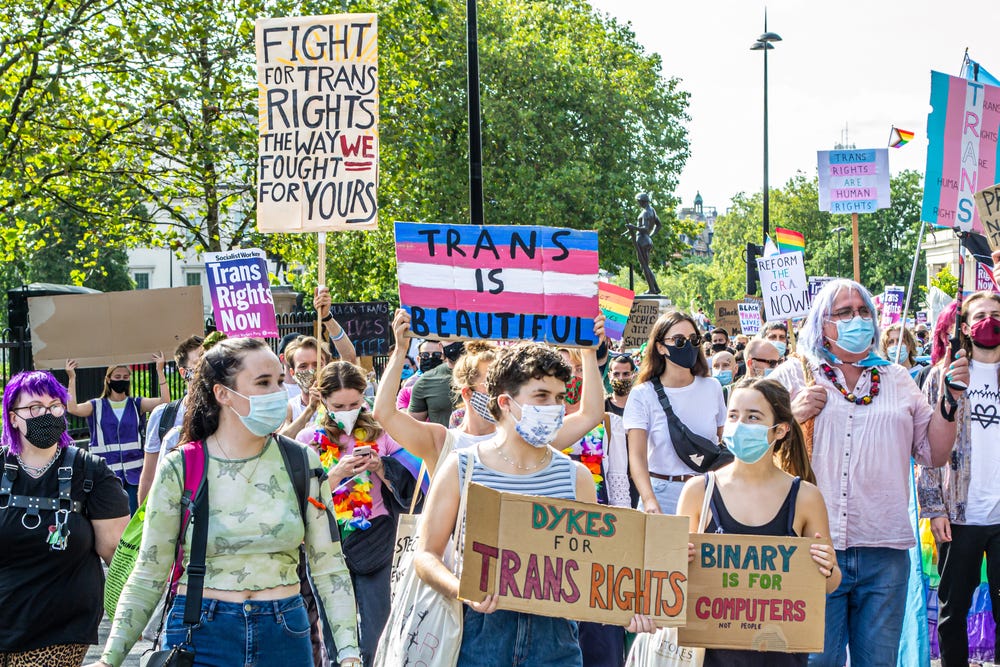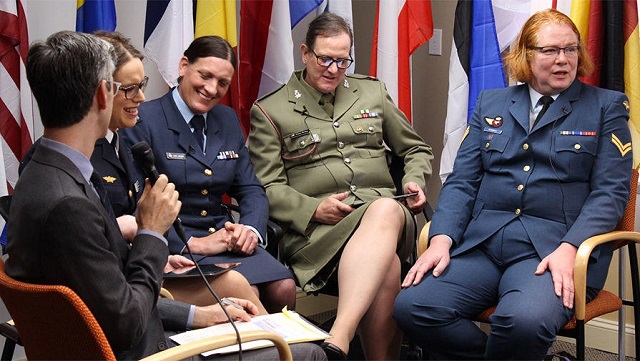Why Are More Children Identifying As Transgender & Being Offered Medical Treatment?
Arjun Walia
First off, let me say that I hold no ill will against transgender people, or anyone for that matter. I believe everybody should be treated with love, respect and understanding. It’s completely fine for anybody to be whatever they desire. Who or what someone chooses to be should not impede on their access to the same rights and freedoms that everybody else has. But we should be able to have discussions, like the one below, while simultaneously pushing for equality and inclusion.
When I was very young, maybe about four or five years old, I used to watch my mother put on makeup, and I wanted to try doing the same thing. It wasn’t the only thing I imitated as a child, I was naturally curious and it’s not uncommon for children to do this.
For a short period of time, I used to try taping her earrings to my ears and sometimes even tried putting on her makeup and lipstick. At that time it was fun pretending to be a girl. I laugh when I think about it now, and I remember my parents doing the same when I did this in the past.
But times have changed, and in some cases if a child were to do this today they might be encouraged to ‘play that role,’ so to speak. Parents may sit down with the child and ask if he wants to be a girl, and if it were me at that age, at that time and in that moment, I could have said yes. I wouldn’t have truly understood what they were asking.
The Pulse is a reader-supported publication. To receive new posts and support my work, consider becoming a free or paid subscriber.
Who knows, maybe some parents today would encourage the child (if it was a male like me) to continue dressing like a girl, and ‘being a girl,’ whatever that means. Perhaps they may even go as far as being taken to a doctor and offered medical treatment like hormone blockers that could affect that child for the rest of its life.
I bring up this topic because more adolescents these days, with no prior history of gender dysphoria, are presenting themselves at gender clinics.
What Is Happening?
Gender dysphoria is defined as the distress caused by a discrepancy between a person’s gender identity and the one assigned to them at birth. I would imagine this is very different from what I did and experienced as a child. I don’t ever remember being confused about my gender, or feeling like I was confused.
A 2022 analysis of insurance claims by Komodo Health found that approximately 18,000 US minors started taking puberty blockers or hormones from 2017 to 2021. The numbers are increasing every single year.
Surveys that have attempted to measure prevalence of this phenomenon have found that approximately 2% of high school aged teens identify as “transgender.”
In 2021, approximately 42,000 children and teenagers across the US received a diagnosis of “gender dysphoria.” This is more than triple the number in 2017, and we are likely to see the same trends when data from 2022 and beyond is released.
Overall, the analysis found that at least 121,882 children ages 6 to 17 were diagnosed with gender dysphoria from 2017 through 2021. In the US, the number of private clinics that focus on providing hormones and surgeries has grown from just a few a decades ago to more than 100.
The Problems With Treatments
As with other medical treatments, there are health related complications that come with these medications and treatments. Medical treatments can include puberty blockers, sex hormones, and surgeries.
There are those, for example, who refer to themselves as “detransitioners” or “retransitioners.” Some of these people claim that early treatment has caused them harm. We will get to a few examples later in the article. We do know that long term research on these treatments is severely lacking.
Two recent studies (see here and here) suggest that as many as 20-30% of patients may discontinue hormone treatment within a few years due to various medical complications.
How Do We Know These Young People Know This Is Actually Right For Them?
An article written by investigative reporter Jennifer Block, published by the British Medical Journal (BMJ) outlines one story that highlights the consequences of these decisions that are now coming to light, and there are a plethora of them.
“Chloe Cole, now aged 18, had a double mastectomy at age 15 and spoke at the AAP rally. “Many of us were young teenagers when we decided, on the direction of medical experts, to pursue irreversible hormone treatments and surgeries,” she read from her tablet at the rally, which had by this time moved indoors to avoid confrontation. “This is not informed consent but a decision forced under extreme duress.”
Chloe, according to her, was indoctrinated, affirmed, and set on an irreparable path at the age of 15. Now she finds herself abandoned by the community and the doctors that led her over the edge.
She started her transition at 12 years old, puberty blockers and testosterone at 13, and had a double mastectomy at 15 years old. She is now a strong advocate against gender ideology. You can watch an interview with her and Jordan Peterson here to learn more about her thoughts, experiences and opinions.
When a female takes testosterone, the permanent effects of the hormone can be seen in months. Voices drop, beards sprout, body fat is redistributed. Sexual interest explodes, aggression increases, and mood can be unpredictable.
Are teenagers even capable of fully grasping what it means to make the decision to become infertile while still a minor? While their brain is still developing? Are they, and the doctors who provide this medication aware that there are still many health safety issues and concerns with transitioning?
We are now starting to see examples of this pop up everywhere, but there doesn’t seem to be a grounded enough discussion on the matter as it has become rather political.
Several studies have estimated that 60 to 90 per cent of children who identify as transgender no longer want to transition by the time they’re adults.
Is this not a fact worth noting before we send people unquestionably on an irreparable path?
Sadly, any attention or awareness brought to this is considered “politically incorrect.” All we hear are cries for inclusion and equality, which is great, but another side to this saga seems to be completely unknown by the ‘mainstream’ (for lack of a better word) portion of the citizenry.
The Pulse is a reader-supported publication. To receive new posts and support my work, consider becoming a free or paid subscriber.
Jamie Reed’s Story
Another story I recently came across was from an article published in The Free Press by Jamie Reed, a 42-year-old St. Louis native, a queer woman.
The article is titled “I Thought I Was Saving Trans Kids. Now I’m Blowing the Whistle.” For almost four years she worked at The Washington University School of Medicine Division of Infectious Diseases with teens and young adults who were HIV positive. Many of them were trans or otherwise gender nonconforming, so she could relate.
In 2018 she started as a case manager at The Washington University Transgender Center at St. Louis Children’s Hospital.
In her article she details her experience in the medical field, working with adolescents who wanted to transition, and how easy it was for them to do so. What struck me is that most of these people had many comorbidities: depression, anxiety, ADHD, eating disorders, obesity. Many were diagnosed with autism, or had autism-like symptoms.
A report last year on a British pediatric transgender center found that about one-third of the patients referred there were on the autism spectrum.
Many also claimed to have illnesses they didn’t really have. According to Reed,
“The doctors privately recognized these false self-diagnoses as a manifestation of social contagion. They even acknowledged that suicide has an element of social contagion. But when I said the clusters of girls streaming into our service looked as if their gender issues might be a manifestation of social contagion, the doctors said gender identity reflected something innate.”
Is it a coincidence that the exponential rise in prevalence of this issue goes hand in hand with the rise of the mental health crises we are seeing in today’s youth? Should we really be making it so easy, without question, for one to transition and simply believe that it’s natural, normal, and the result of something internal or biological that we have yet to discover?
Is this a biological issue, or a mental health issue? Don’t get me wrong, this doesn’t mean that all who want to transition are mentally ill! That’s not what I am saying, but in today’s society it’s sad that we can’t even discuss this possibility despite a plethora of evidence showing that some of it may be true.
Think of the contrast, the mainstream is incredibly quick to label those who don’t trust government as mentally ill, yet won’t even question whether it’s the case for folks that are making irreparable decisions around their body.
Reed goes on to explain,
‘To begin transitioning, the girls needed a letter of support from a therapist—usually one we recommended—who they had to see only once or twice for the green light. To make it more efficient for the therapists, we offered them a template for how to write a letter in support of transition. The next stop was a single visit to the endocrinologist for a testosterone prescription.
That’s all it took.”
Sure, I wouldn’t question or kick up a fuss if no harm was being done, but this is not the case. There are no reliable studies showing this. There are so many experiences and examples, especially from the centre that Reed worked at, where patients prove how false these assertions are.
Reed brings this up in her story,
“Many encounters with patients emphasized to me how little these young people understood the profound impacts changing gender would have on their bodies and minds. But the center downplayed the negative consequences, and emphasized the need for transition. As the center’s website said, “Left untreated, gender dysphoria has any number of consequences, from self-harm to suicide. But when you take away the gender dysphoria by allowing a child to be who he or she is, we’re noticing that goes away. The studies we have show these kids often wind up functioning psychosocially as well as or better than their peers.”
All this being said, at least 20 people, including parents of patients and patients themselves, have given accounts that directly challenge the key claims made by Reed.
When it comes to safety and efficacy, in North America various organizations, like The Endocrine Society, support medical interventions for transgender people. They claim that they are extremely safe and effective, and backed by years of research.
The World Professional Association for Transgender Health (WPATH) is probably the dominant organization. Various medical associations base their guidelines on recommendations from this institution.
According to WPATH,
“WPATH recommends that young people have access to treatments after comprehensive assessment, stating that the “emerging evidence base indicates a general improvement in the lives of transgender adolescents.” And more globally, WPATH asserts, “There is strong evidence demonstrating the benefits in quality of life and well-being of gender-affirming treatments, including endocrine and surgical procedures,” procedures that “are based on decades of clinical experience and research; therefore, they are not considered experimental, cosmetic, or for the mere convenience of a patient. They are safe and effective at reducing gender incongruence and gender dysphoria.”
But, like we see with many other medical interventions, this sentiment isn’t the same across the globe, as Block points out in her BMJ article,
“Internationally, however, governing bodies have come to different conclusions regarding the safety and efficacy of medically treating gender dysphoria. Sweden’s National Board of Health and Welfare, which sets guidelines for care, determined last year that the risks of puberty blockers and treatment with hormones “currently outweigh the possible benefits” for minors. Finland’s Council for Choices in Health Care, a monitoring agency for the country’s public health services, issued similar guidelines, calling for psychosocial support as the first line treatment. (Both countries restrict surgery to adults.)
Medical societies in France, Australia, and New Zealand have also leant away from early medicalization. And NHS England, which is in the midst of an independent review of gender identity services, recently said that there was “scarce and inconclusive evidence to support clinical decision making” for minors with gender dysphoria and that for most who present before puberty it will be a “transient phase,” requiring clinicians to focus on psychological support and to be “mindful” even of the risks of social transition.”
Multiple systematic reviews have also found that the strength of evidence for the conclusions that hormonal treatment “may improve” quality of life, depression, and anxiety among transgender people was “low,” and it emphasized the need for more research, especially among adolescents.
There is no shortage of doctors and organizations who are expressing the devastating effects that puberty blockers, cross-sex hormones, and surgical modifications can have on children’s developing bodies, regardless of how ‘politically incorrect’ these truths may be.
We are entering a dangerous phase in society where these types of sentiments can only be discussed behind closed doors, are unable to be shared within mainstream media and academia, or perhaps even posted on social media.
The Pulse is a reader-supported publication. To receive new posts and support my work, consider becoming a free or paid subscriber.
Ancient History
Transgender people have existed since ancient times. A wide range of societies had traditional third gender roles, or otherwise accepted trans people in some form. A precise history is difficult because the modern concept of being transgender, and gender in general, did not develop until the mid-1900s.
For example, around 5000 to 3000 B.C., Gala, described as androgynous or trans priests of the Sumerian goddess Inanna, spoke their own dialect and took on feminine names. Around the 18th century, the Itelmens of Siberia recognized a “third gender” called “koekchuch” to describe individuals who were assigned male at birth, but expressed themselves as women.
There are countless examples.
There’s nothing wrong with this, everybody should have the right to do this and not be condemned in any way shape or form. It should simply be viewed as normal in today’s society.
But this is not the case, sexual and gender minorities (SGM)—including lesbian, gay, bisexual, and transgender (LGBT) people—experience significant discrimination and stigmatization in many places around the world, including many human rights violations.
What’s different now, however, are medical interventions, why they are happening, how easy it is and the lack of rigour that goes into investigating the phenomenon of why children and adolescents want to transition in today’s society.
As Reed mentioned above, social contagion is never discussed and is instantly dismissed as one explanation. I do believe that pop culture, celebrities and more have all been made examples of for the sake of inclusion. Sometimes I wonder what type of influence this has on the prevalence of gender dysphoria. What about children’s cartoons, shows and the idea that these communities will be receiving more ‘representation’ within the mainstream. Could this influence prevalence? Is it fair that this representation is happening without a proper discussion about the points brought up in this article? What’s going on?
When I finished my degree and then applied to teachers college, I remember reading in the application that if I identify as an ethnic minority, my chances would be greater of receiving an acceptance. This was because of the lack of representation in our schools. This lack of representation was blamed on ‘institutional racism’ despite no evidence showing that racism was the actual cause. Everybody just accepted it.
Meanwhile, I was sitting there thinking that giving me an advantage based on my race is in itself, racist.
All of these thoughts, issues and more and how they relate to gender dysphoria are perhaps better saved for another article.
Thanks for reading. I would love to hear your perspective on this issue in the comments section below!
THANKS TO: https://www.thepulse.one/p/why-are-more-children-identifying?utm_source=post-email-title&publication_id=1252422&post_id=108023065&isFreemail=true&utm_medium=email
Related posts:
Views: 0
 RSS Feed
RSS Feed

















 March 15th, 2023
March 15th, 2023  Awake Goy
Awake Goy 







 Posted in
Posted in  Tags:
Tags: 
















